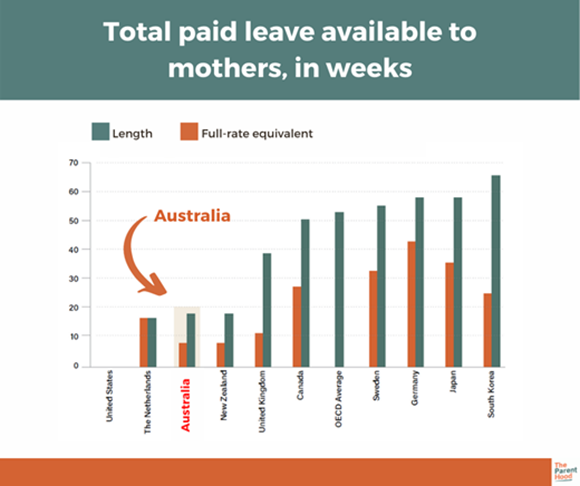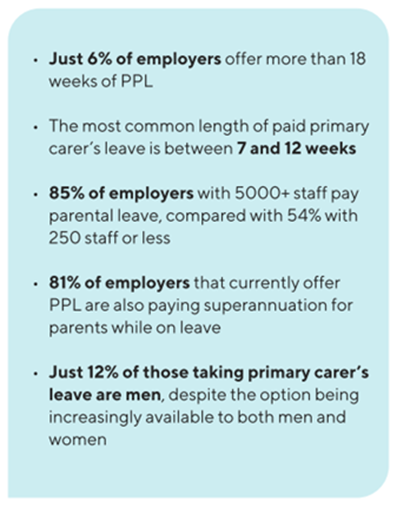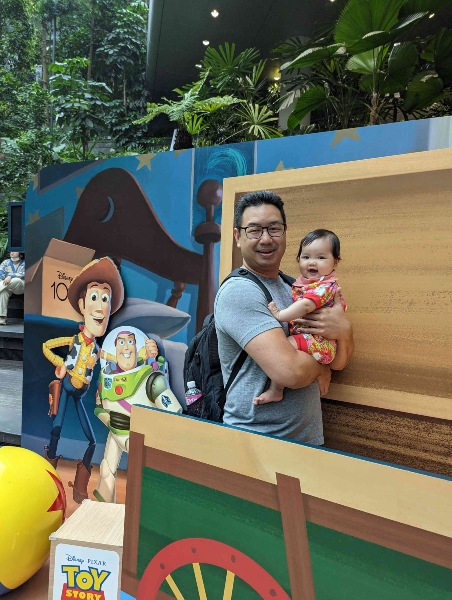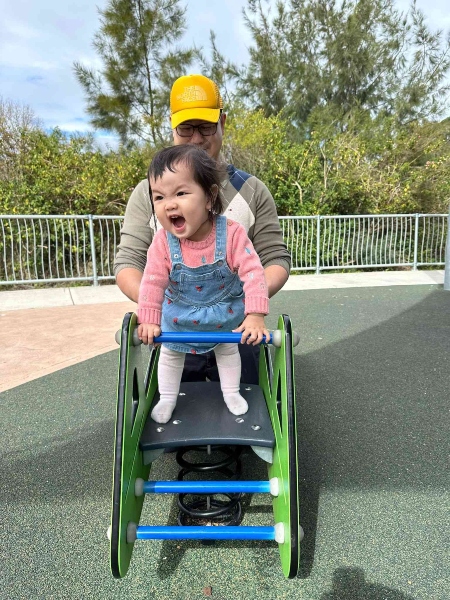The current landscape of Commonwealth-funded Paid Parental Leave scheme
From July 1 2023, the Australian government increased the duration of Paid Parental Leave (PPL) to 20 weeks for both parents to access and share, with an extra two weeks to be added to the scheme every year until it reaches 26 weeks in 2026. This policy change promises to create a profound impact on the lives of families welcoming children in a more equitable and inclusive era for parental leave.
Some experts say proposed reforms are still not enough as Australia still lags behind other OECD (The Organisation for Economic Co-operation and Development) countries when taking into consideration the average payment rate. (Note: Our current PPL scheme is based on the national minimum wage, rather than an earnings-dependent formula.)
Countries like Iceland, Norway and Finland have PPL schemes that pay new parents more than a year of entitlements, at around 80% of a parent’s wage.
 Credit: The Parenthood
Credit: The Parenthood
While new policy changes help to normalise fathers' use of parental leave and signal that parenting is a shared and equal partnership, more is required to encourage more men to take up the leave and transform shared caring responsibilities.
The need for encouraging men to embrace parental leave
Although most families could agree the recent policy changes area step in the right direction, they come amidst a broader challenge – the need for encouraging fathers to actively participate in shared parenting responsibilities.
According to the whitepaper released by Parents At Work in July 2023, only 12% of those taking primary carer’s leave are men, despite more than half of employers now offering it to men and women.

Women continue to bear the disproportionate financial disadvantage to taking time out of the workforce. Some studies have shown this ’motherhood penalty’ results in around 80% of the gender pay gap. There is still very much a stigma that taking care of children is a ‘mother’s job’, and this leaves both men and women with caring responsibilities fearing a sense of isolation and workplace discrimination.
A recent research from the Gidget Foundation found that only one in three new fathers felt well supported by their workplace after having a child, with only one in five feeling supported during their partner’s pregnancy.
As mentioned in our previous article, men taking parental leave leads to better outcomes for everyone. Fathers get more valuable time with their children, mothers have better opportunities to pursue paid work and their careers, children benefit from stronger connections with both their parents, and employers also report better employee retention and productivity. On a macro level, improving the distribution of work and care within families would also lead to a reduction in the gender pay gap and higher GDP through increased female work participation. As the Chief executive of parent advocacy group The Parenthood, Jessica Rudd, points out, "Removing all barriers in Australia could see an extra 461,000 full-time people enter the workforce and an extra $128 billion a year added to the economy."
The Road Ahead: Promoting Shared Care in Australia
Achieving paid-parental leave equality in Australia requires a multifaceted approach. It will take both the government and employers to seriously invest in funding and advocacy to shift the current status quo.
- Legislative CLegislative Considerations: Exploring potential legislative adjustments could involve incentivising fathers to take parental leave, such as offering extended paid leave options, enhanced job protection, and implementing a "use it or lose it" approach. Additionally, research suggests that refining the paid maternity leave structure to reflect prior earnings, rather than merely extending time off work, may contribute to more equitable outcomes for Australian families.
- Employer Initiatives: The length and funding of the Commonwealth-funded PPL is unlikely to deliver a significant uptick in men sharing the leave, which is why employers play a pivotal role in complementing the government scheme and creating a supportive environment for parental leave. Initiatives such as flexible work arrangements and paying superannuation during periods of parental leave. Employers should also strive for removing stigma and gender bias that persists in workplaces to foster a culture that makes everyone feel safe or affordable to take parental leave.
- Public Awareness Campaigns: Societal perceptions need to change. Public awareness campaigns can help challenge stereotypes and stigmas surrounding fathers taking parental leave. Highlighting positive role models and success stories can be particularly effective.
- Support Networks: The creation of support networks and forums where fathers can openly discuss their experiences with parental leave can help them feel more comfortable taking this step.
To further advance shared care in Australia, it is essential to examine the practices of leading nations and consider legislative changes, employer initiatives, public awareness campaigns, and the development of support networks. By actively addressing these challenges and fostering a culture of acceptance and support, that’s how we can move closer to achieving gender equality and shared parenting responsibilities for Australian families.
Employee story: Jason Sin
Here's Jason Sin, our Development Manager of Delivery, sharing his experiences on taking parental leave. Read on to learn more about Jason’s experiences as a new Dad!
What’s your story?
Since welcoming my daughter into my family, me and my partner's lives revolve around my daughter. I always make time for my family and ensure work is transactional. I enjoy travelling and went abroad to Singapore with a 6 month old and it was a new experience - let's just say my planned itinerary went out the window.

What type of parental leave did you take, and how has it affected you and/or your partner?
I started my family journey in June 2022. My manager advised me of TG's industry-leading paid parental leave. Being provided the opportunity to become the primary carer, I understand the roller coaster ride - “joy, stress, satisfaction and tiredness” - experienced by new mothers. It was an insightful experience and I appreciate my partner more than words can describe and have a deep respect for all mothers.
When a colleague tells me they are expecting, I point them to this provision, tell them about my own experience and highly encourage them to share the family load.

Who/what inspires you to be your best?
My family inspires me to be the best. I am only a small cog in a large machine, however, my contribution in the industry transition to renewable energy will ensure my family and future generations have a brighter and greener future freed of climate change.

